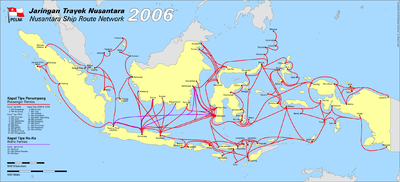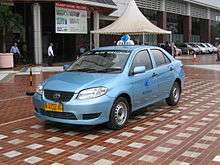Transport in Indonesia

Indonesia's transport system has been shaped over time by the economic resource base of an archipelago with thousands of islands, and the distribution of its more than 200 million people highly concentrated on a single island, Java.[1]
All transport modes play a role in the country’s transport system and are generally complementary rather than competitive. Road transport is predominant, with a total system length of est 438,000 km in 2008. The railway system has four unconnected networks in Java and Sumatra primarily dedicated to transport bulk commodities and long-distance passenger traffic. Sea transport is extremely important for economic integration and for domestic and foreign trade. It is well developed, with each of the major islands having at least one significant port city. The role of inland waterways is relatively minor and is limited to certain areas of Eastern Sumatra and Kalimantan. The function of air transport is significant, particularly where land or water transport is deficient or non-existent. It is based on an extensive domestic airline network where all major cities can be reached by passenger plane.
Merchant marine vessels


Because Indonesia encompasses a sprawling archipelago, maritime shipping provides essential links between different parts of the country. Boats in common use include large container ships, a variety of ferries, passenger ships, sailing ships, and smaller motorised vessels. Traditional wooden vessel pinisi still widely used as the inter-island freight service within Indonesian archipelago. Main pinisi traditional harbours is Sunda Kelapa in Jakarta and Paotere harbour in Makassar.
Frequent ferry services cross the straits between nearby islands, especially in the chain of islands stretching from Sumatra through Java to the Lesser Sunda Islands. On the busy crossings between Sumatra, Java, and Bali, multiple car ferries run frequently twenty-four hours per day. There are also international ferry services between across the Straits of Malacca between Sumatra and Malaysia, and between Singapore and nearby Indonesian islands, such as Batam.
A network of passenger ships makes longer connections to more remote islands, especially in the eastern part of the archipelago. The national shipping line, Pelni, provides passenger service to ports throughout the country on a two to four week schedule. These ships generally provide the least expensive way to cover long distances between islands. Still smaller privately run boats provide service between islands.
On some islands, major rivers provide a key transportation link in the absence of good roads. On Kalimantan, longboats running on the rivers are the only way to reach many inland areas.
Waterways
Indonesia has 21,579 km of navigable waterways (As of 2005), of which about one half are on Kalimantan, and a quarter each on Sumatra and Papua. Waterways are highly needed because the rivers on these islands are not wide enough to hold medium-sized ships. In addition to this, roads and railways are not good options since Kalimantan and Papua are not like Java, which is a highly developed island.[2] With the current length of waterways, Indonesia ranked seventh on the countries with longest waterways.[3]
Ports and harbours
Major ports and harbours include Bitung, Cilacap, Cirebon, Jakarta, Kupang, Palembang, Semarang, Surabaya, and Makassar. Ports are managed by the various Indonesia Port Corporations, of which there are four, numbered I through IV. Each has jurisdiction over various regions of the country, with I in the west and IV in the east.
Roads and highways

A wide variety of vehicles are used for transportation on Indonesia's roads. Bus services are available in most areas connected to the road network. Between major cities, especially on Sumatra, Java, and Bali, services are frequent and direct; many services are available with no stops until the final destination. In more remote areas, and between smaller towns, most services are provided with minibuses or minivans (angkut). Buses and vans are also the primary form of transportation within cities. Often, these are operated as share taxis, running semi-fixed routes.
Many cities and towns have some form of transportation for hire available as well such as taxis. There are usually also bus services of various kinds such as the Kopaja buses and the more sophisticated Transjakarta bus rapid transit system in Jakarta. Many cities also have motorised autorickshaws (bajaj) of various kinds. Cycle rickshaws, called becak in Indonesia, are a regular sight on city roads and provide inexpensive transportation. They have been blamed for causing traffic congestion and, consequently, banned from most parts of central Jakarta. Horse-drawn carts are found in some cities and towns.
Due to the increasing purchasing power of Indonesians, private cars are becoming more common especially in major cities. However the growth of the number of cars increasingly outpaces the construction of new roads, resulting in frequently crippling traffic jams in large parts in major cities especially in Jakarta, which often also happen on highways. Jakarta also has one of the worst traffic jams in the world.

The AH2 highway is one of Indonesia's main highways. The other one is AH25 in Sumatra.
Indonesia has about 213,649 km of paved highways and about 154,711 km of unpaved highways (As of 2002 estimate).
Indonesia has some highways, some of them are National Routes (25, currently only in Java and (partially) Sumatera), and some of them are freeways. All the freeways are tolled (toll road). The most expensive is the Cipularang Toll road that connects Jakarta and Bandung via Cikampek and Purwakarta.
Indonesia has also been gradually introducing an Intelligent Transportation System (ITS) since 2012. ITS Indonesia was formed on 26 April 2011.[4]
National routes
Toll roads


Java
Sumatra
- Belawan-Medan-Tanjung Morawa Toll Road (Belmera Toll Road)
Planned :
- Medan-Kuala Namu International Airport-Tebing Tinggi, 80 percent of the land needed for the toll road construction is owned by state plantation which it is easy to take over, whether the remaining 20 percent is owned by local residents which it is difficult to take over due to unreasonably high prices.[5]
- Medan-Binjai Toll Road[6]
- Pekanbaru-Kandis-Duri-Dumai Toll Road[7]
- Palembang-Indralaya Toll Road[8]
- Tegineneng-Babatan Toll Road[9]
Sulawesi
- Makassar-Sultan Hasanuddin International Airport Toll Road
- Makassar Section 1,2,3,4 Toll Road
Planned:
- Manado-Bitung Toll Road[10]
Bali
- Serangan-Tanjung Benoa Toll Road
The toll road between Tanjung Benoa to Airport and from Airport to Serangan, all in direct line (not curve) is 12.7 kilometres and is equipped also with motorcycle lanes. The toll road is formally opened on 23 September 2013, about a week before APEC Summit in Bali is opened.[11]
Railways
The majority of Indonesia's railways is located on Java, used for both passenger and freight transport. The inter-city rail network on Java is complemented by local commuter rail services in the Jakarta metropolitan area (KRL Jabotabek) and in Surabaya. In addition, monorail and mass rapid transit systems are under construction in Jakarta. There are three separate railway networks on Sumatra: one in Aceh and North Sumatra, another in West Sumatra, and the final one in South Sumatra and Lampung. Other railways do not exist in Indonesia, although a new (industrial) network is being developed on Kalimantan.[12]
Pipelines
Crude oil 2,505 km; petroleum products 456 km; natural gas 1,703 km (1989)
Air transport

Air transportation in Indonesia serves as a critical means of connecting the thousands of islands throughout the archipelago. Between 2010 and 2013 the number of Indonesia's air passengers increased over 43% from 59,384,362 to 85,102,827.[13]
Airports
Jakarta's Soekarno–Hatta International Airport serves as the country's main air transportation hub. However safety issues continue to be problematic. Several recent accidents have helped make Indonesia's air transport system one of the least safe in the world.[14]
Total: 676 (2012)
- Airports - with paved runways[15]
- over 3,047 m: 5
- 2,438 to 3,047 m: 21
- 1,524 to 2,437 m: 51
- 914 to 1,523 m: 72
- under 914 m: 37
- Total: 186 (2013)
- Airports - with unpaved runways[16]
- 1,524 to 2,437 m: 4
- 914 to 1,523 m: 23
- under 914 m: 460
- Total: 487 (2013)
- Heliports[17]
- Total: 76 (2013)
Airlines
National airline:
- Garuda Indonesia
- Merpati Nusantara Airlines (bankrupt)
Other airlines
See also
References
- ↑ Indonesia's Diversity Revisited http://cip.cornell.edu/Dienst/UI/1.0/Summarize/seap.indo/1107012385
- ↑ Politics and Business Indonesia http://kerrycollison.net/index.php?/archives/2805-Politics-and-Business-Mix-in-Indonesia.html
- ↑ Rank Order - Waterways https://www.cia.gov/library/publications/the-world-factbook/rankorder/2093rank.html
- ↑ http://www.antaranews.com/en/news/74080/ri-to-adopt-its-gradually-starting-in-2012
- ↑ http://www.thejakartapost.com/news/2011/04/25/land-clearing-ignites-inevitable-conflict.html
- ↑ http://www.bpjt.net/index.php?id=54
- ↑ http://www.bpjt.net/index.php?id=54
- ↑ http://www.bpjt.net/index.php?id=54
- ↑ http://www.bpjt.net/index.php?id=54
- ↑ http://www.bpjt.net/index.php?id=54
- ↑ "Awaiting an Opening". Retrieved 30 April 2014.
- ↑ New railway on Kalimantan
- ↑ World Bank Datebase, http://data.worldbank.org/indicator/IS.AIR.PSGR
- ↑ "Safety woeful, admits air chief." Sydney Morning Herald online, 2 November 2007 - 2:17PM.
- ↑ "Field Listing: Airports - with paved runways: Indonesia". CIA World Factbook. Retrieved 8 December 2015.
- ↑ "Indonesia Airports - with unpaved runways". Index Mundi. Retrieved 8 December 2015.
- ↑ "Field Listing: Heliports: Indonesia". CIA World Factbook. Retrieved 8 December 2015.

